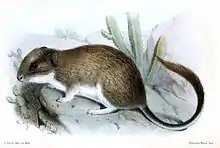Mountain degu
The mountain degu (Octodontomys gliroides) is a species of rodent in the family Octodontidae. It is the only species in the genus Octodontomys.[2] It is found in the foothills of the Andes in Argentina, Bolivia and Chile.
| Mountain degu | |
|---|---|
 | |
| Scientific classification | |
| Domain: | Eukaryota |
| Kingdom: | Animalia |
| Phylum: | Chordata |
| Class: | Mammalia |
| Order: | Rodentia |
| Family: | Octodontidae |
| Genus: | Octodontomys Palmer, 1903 |
| Species: | O. gliroides |
| Binomial name | |
| Octodontomys gliroides | |
Description
The mountain degu is a moderate sized rodent with a length of 200 to 380 mm (8 to 15 in), including a tail of 100 to 190 mm (4 to 7 in), and a bodyweight in the range 100 to 200 grams (4 to 7 oz). The hairs are long and silky. The upper surface is greyish-brown, the chin is pure white, and the underparts are white with a grey base to the hairs. There is a tuft of white hair in front of the large ears, which are clad in short grey hair. The slender tail is bi-coloured (dark above and pale below) and has a tuft of brown or ochre hairs at the tip. Juveniles have darker fur above and greyer underparts. Their tails are brownish with a dark brown or black tufted tip.[3]
Distribution and habitat
This species is found in the mountainous areas of southwestern Bolivia, northwestern Argentina and northern Chile. It has a wide altitudinal range, occurring at 200 to 300 metres (660 to 980 ft) in Jujuy Province in Argentina, and at 4,400 metres (14,400 ft) in Potosí Department in Bolivia. The only species of octodontid found in the higher parts of its range, it inhabits dry rocky areas with tall cacti, shrubs and herbs.[3]
Behaviour
The mountain degu is a mainly diurnal, herbivorous rodent. It does not have any special adaptations of skull or limbs for tunnelling but digs short burrows as well as living under rocks and in caves. Its tail can be autotomised and when climbing, it can be used as a prop. It is a sociable animal and communicates by means of a range of low, medium and high-pitched gurgles, twitters and squeaks. It feeds on the leaves and bark of shrubs, and on Acacia sheaths in the winter and on cactus fruits in the summer. It can obtain sufficient moisture from its food, particularly cactus, to satisfy its water requirements.[3]
Little is known of the breeding habits of the mountain degu, but young in various stages of development have been found in November, and pregnant females and young in both January and May. A gestation period of around 105 days has been reported with a litter size of one to three pups. The pups are precocial when born, already having their eyes open and being well-furred.[3]
Status
O. gliroides is listed as being of "least concern" by the International Union for Conservation of Nature because of its wide distribution, its presumed large population, its occurrence in some protected areas and apparent tolerance of some degree of habitat modification.[1]
References
- Weksler, M. (2016). "Octodontomys gliroides". IUCN Red List of Threatened Species. 2016: e.T15091A22240265. doi:10.2305/IUCN.UK.2016-2.RLTS.T15091A22240265.en. Retrieved 11 November 2021.
- Woods, C.A.; Kilpatrick, C.W. (2005). "Genus Octodontomys". In Wilson, D.E.; Reeder, D.M (eds.). Mammal Species of the World: A Taxonomic and Geographic Reference (3rd ed.). Johns Hopkins University Press. p. 1572. ISBN 978-0-8018-8221-0. OCLC 62265494.
- James L. Patton; Ulyses F. J. Pardiñas; Guillermo D'Elía (9 March 2015). Mammals of South America, Volume 2: Rodents. University of Chicago Press. pp. 1035–1037. ISBN 978-0-226-16960-6. OCLC 904333770.
